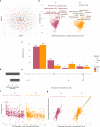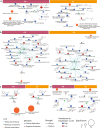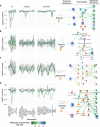Expanding the drug discovery space with predicted metabolite-target interactions
- PMID: 33674782
- PMCID: PMC7935942
- DOI: 10.1038/s42003-021-01822-x
Expanding the drug discovery space with predicted metabolite-target interactions
Abstract
Metabolites produced in the human gut are known modulators of host immunity. However, large-scale identification of metabolite-host receptor interactions remains a daunting challenge. Here, we employed computational approaches to identify 983 potential metabolite-target interactions using the Inflammatory Bowel Disease (IBD) cohort dataset of the Human Microbiome Project 2 (HMP2). Using a consensus of multiple machine learning methods, we ranked metabolites based on importance to IBD, followed by virtual ligand-based screening to identify possible human targets and adding evidence from compound assay, differential gene expression, pathway enrichment, and genome-wide association studies. We confirmed known metabolite-target pairs such as nicotinic acid-GPR109a or linoleoyl ethanolamide-GPR119 and inferred interactions of interest including oleanolic acid-GABRG2 and alpha-CEHC-THRB. Eleven metabolites were tested for bioactivity in vitro using human primary cell-types. By expanding the universe of possible microbial metabolite-host protein interactions, we provide multiple drug targets for potential immune-therapies.
Conflict of interest statement
A.N., S.S., C.J., J.T and J.R.B. were all employees of GlaxoSmithKline at the time of this study. E.B. is an employee of Eurofins.
Figures





Similar articles
-
Unravelling metabolite-microbiome interactions in inflammatory bowel disease through AI and interaction-based modelling.Biochim Biophys Acta Mol Basis Dis. 2025 Mar;1871(3):167618. doi: 10.1016/j.bbadis.2024.167618. Epub 2024 Dec 9. Biochim Biophys Acta Mol Basis Dis. 2025. PMID: 39662756
-
Metabolic Functions of Gut Microbes Associate With Efficacy of Tumor Necrosis Factor Antagonists in Patients With Inflammatory Bowel Diseases.Gastroenterology. 2019 Nov;157(5):1279-1292.e11. doi: 10.1053/j.gastro.2019.07.025. Epub 2019 Jul 18. Gastroenterology. 2019. PMID: 31326413
-
Deciphering microbial and metabolic influences in gastrointestinal diseases-unveiling their roles in gastric cancer, colorectal cancer, and inflammatory bowel disease.J Transl Med. 2025 May 16;23(1):549. doi: 10.1186/s12967-025-06552-w. J Transl Med. 2025. PMID: 40380167 Free PMC article.
-
The Innate and Adaptive Immune System as Targets for Biologic Therapies in Inflammatory Bowel Disease.Int J Mol Sci. 2017 Sep 21;18(10):2020. doi: 10.3390/ijms18102020. Int J Mol Sci. 2017. PMID: 28934123 Free PMC article. Review.
-
The crosstalk between gut bacteria and host immunity in intestinal inflammation.J Cell Physiol. 2021 Apr;236(4):2239-2254. doi: 10.1002/jcp.30024. Epub 2020 Aug 27. J Cell Physiol. 2021. PMID: 32853458 Review.
Cited by
-
Investigating the effects of Liushen Capsules on the metabolome of seasonal influenza: A randomized clinical trial.Front Pharmacol. 2022 Aug 11;13:968182. doi: 10.3389/fphar.2022.968182. eCollection 2022. Front Pharmacol. 2022. PMID: 36034844 Free PMC article.
-
Artificial intelligence and inflammatory bowel disease: Where are we going?World J Gastroenterol. 2023 Jan 21;29(3):508-520. doi: 10.3748/wjg.v29.i3.508. World J Gastroenterol. 2023. PMID: 36688019 Free PMC article. Review.
-
Power in Numbers: The Gut Microbiome Takes the Spotlight.Chem Res Toxicol. 2022 Feb 21;35(2):112-114. doi: 10.1021/acs.chemrestox.1c00344. Epub 2021 Dec 22. Chem Res Toxicol. 2022. PMID: 34936764 Free PMC article.
-
Exploring Microbial Metabolite Receptors in Inflammatory Bowel Disease: An In Silico Analysis of Their Potential Role in Inflammation and Fibrosis.Pharmaceuticals (Basel). 2024 Apr 12;17(4):492. doi: 10.3390/ph17040492. Pharmaceuticals (Basel). 2024. PMID: 38675452 Free PMC article.
-
A Systematic Review of Artificial Intelligence and Machine Learning Applications to Inflammatory Bowel Disease, with Practical Guidelines for Interpretation.Inflamm Bowel Dis. 2022 Oct 3;28(10):1573-1583. doi: 10.1093/ibd/izac115. Inflamm Bowel Dis. 2022. PMID: 35699597 Free PMC article.
References
Publication types
MeSH terms
Substances
LinkOut - more resources
Full Text Sources
Other Literature Sources

